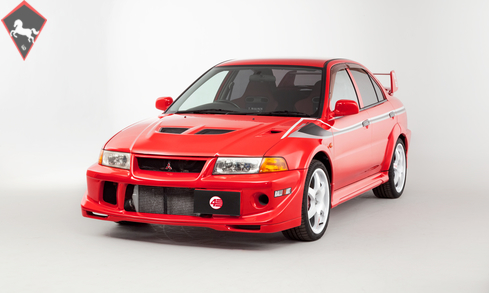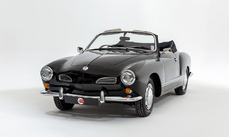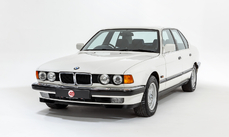Mitsubishi Lancer VI Tommi Makinen 2000
General description :
Model History
The Lancer Evolution was a high-performance sports car based on the standard Mitsubishi Lancer. There have been ten official versions to date, and the designation of each model is most commonly a Roman numeral. All use two-litre, turbocharged engines and all-wheel drive systems.
The Evolution was originally intended only for Japanese markets, but demand on the "grey import" market led the Evolution series to be offered through Ralliart dealer networks in the United Kingdom and in various European markets from around 1998. Japanese-spec cars were limited by a gentlemen's agreement to advertise no more than 276hp, a mark already reached by Evolution IV. Therefore, each subsequent version has unofficially evolved above the advertised power figures, with the Japanese-spec Evolution IX reaching an alleged output of around 317hp.
The Evo VI was produced from January 1999 until March 2001. The improvements over its predecessor mainly focused on cooling and engine durability. It received a larger intercooler, larger oil cooler, and new pistons. The Evolution VI received new bodywork yet again, with the most easily noticeable change being within the front bumper where the huge fog lights were reduced in size and moved to the corners for better airflow.
Great rally success was achieved in the WRC Rallies from 1996-1999 thanks to the legendry Finn Tommi Makinen for clinching the drivers titles in this period and help from team mate Richard Burns for clinching the constructors championship for the first, and thus far only time in 1998.
In 1999 the Tommi Makinen Edition was released. It featured a different front bumper, red and black Recaro seats embossed with the Tommi Makinen logo, 17-inch white Enkei wheels, a red-stitched leather Momo steering wheel and shift knob, a titanium turbine that spooled up more quickly, front upper strut brace, lowered ride height (with tarmac stages in mind), and a quicker steering ratio, among other things. The car is sometimes referred to as an Evolution 6.5, or TME for short.
The Tommi Makinen Edition was only available in Scotia White, Satellite Silver, Pyrenees Black, Canal Blue, and Passion Red (the only colour scheme available with the Works stripes and decals kit). Out of all the colours, the red is considered to be most collectable; certainly the used car market favours it as values are seen to be increasing year on year. In total there were 2,021 GSR and just 678 RS lightweight variants. It is believed that only 212 cars were produced in red with the Special Colour Pack.
Equipment
Special Colour Pack, TME embroidered Recaro front seats, 18-inch Compomotive MO1882 alloy wheels, Front and side airdams, Twin-wing rear spoiler with high-mount stop lamp, Specially tuned suspension, Brembo brakes, Electric-folding door mirrors, Digital climate control AC, Electric windows, Power steering, Momo leather steering wheel with red stitching, Leather gear knob and gaiter with red stitching, Front airbags, Remote central locking, Radio delete, Kakimoto Racing stainless exhaust, Mitsubishi wind deflectors, Privacy glass, Spare wheel.
Exterior
The gleaming Passion Red paintwork looks superb alongside the Works stripes and decals. Visually similar to the Championship winning cars made famous by rally legend Tommi Makinen, it comes as no surprise that Special Colour Pack TMEs like this one have fast become the most sought after of all. Amazingly there is no fading or damage to the bodywork and almost no stone chips to the front end. None of the trims or rubbers have ever been sun-damaged and the decals present extremely well all round.
Interior
The specially-embroidered TME Recaro seats present really well and show few signs of use; the velour bolsters are usually the first areas to wear but these remain in excellent order with no rips or bobbling to report. The dash and centre console are also free from any significant marks and pleasingly there are no aftermarket gauges or controllers fitted. Commonly worn items such as the steering wheel and gear knob are in good original condition, not entirely unworn but perfectly in line with the mileage.
ENGINE & TRANSMISSION
The turbocharged 2-litre rockets the Evo from 0-60 mph in little over 4 seconds. The five-speed manual gearbox still feels tight, and the all-wheel-drive system provides enough confidence to power though corners at speed. Despite its high-performance credentials, the Evo VI still drives with typical Japanese-car ease; operating smoothly at low speeds before launching into ferocious acceleration at anything above 4000 rpm.
The engine bay of this example is remarkably original with absolutely no modifications or aftermarket components fitted; even the factory blow-off valve is still in place. The car presents in excellent mechanical fettle having received a full service, cambelt change, and new clutch at Mitsubishi around 200 miles ago. Sold with a fresh 12 month MOT.
WHEELS, TYRES & BRAKES
The Evo sits on stunning six-spoke Compomotive alloys, all in perfect unmarked condition having seen little use since fitting. They are shod in matching Goodyear rubber with at least 6mm of tread remaining at each corner. Out on the road the Brembo brakes perform effortlessly, stopping the car quickly and in a straight line.
History File
This rare Special Colour Pack Tommi Makinen was first registered in February 2000. It was supplied new in Japan, remaining there until late 2016 when it was imported by 4 Star. It has been carefully stored with us ever since and is now offered for sale for the first time in the UK, fully registered and with 12 months MOT upon sale.
The paperwork is complete with Japanese service history, original owner’s manuals, UK registration documents, and Mitsubishi invoices for the recent cambelt service and clutch replacement; the work was carried out by Farnham Mitsubishi little over 200 miles ago at a cost of over £2,800.
http://www.4starclassics.com/for-sale/mitsubishi-evo-vi-tommi-makinen-for-sale/
2000 Mitsubishi Lancer VI Tommi Makinen is listed sold on ClassicDigest in Kingsley by 4 Star Classics for £39995.
Car Facts
Car type : Car Make : Mitsubishi Model : Lancer Model Version : VI Tommi Makinen Engine size : 2.0 Model Year : 2000 Sub type : Pick up Location : Hampshire
Sold
Seller Information
Sold
People who viewed this Mitsubishi Lancer also viewed similar Mitsubishi listed at ClassicDigest
Other cars listed for sale by this dealer
About Mitsubishi
Mitsubishi: A Journey Through History (Up to the 1980s)**1. Early Beginnings:
Foundation: Mitsubishi's roots trace back to the establishment of a shipping firm by Yataro Iwasaki in 1870.
Diversification: The company expanded into coal mining, shipbuilding, and other industries, forming the basis for the Mitsubishi Group.
**2. Automotive Ventures Begin:
Initial Automobile Production: Mitsubishi ventured into automobile manufacturing in the early 20th century.
Model-A: In 1917, Mitsubishi introduced its first production car, the Model-A, Japan's first series-production automobile.
**3. Post-War Era:
Restructuring: Following World War II, Mitsubishi faced challenges but underwent restructuring and resumed automobile production.
Jeep Production: Initially focused on producing Jeeps, Mitsubishi made significant contributions to Japan's automotive recovery.
**4. Milestone Models:
Mitsubishi 500: Introduced in 1960, the Mitsubishi 500 was a compact car that played a role in popularizing smaller vehicles in Japan.
Mitsubishi Colt 600: Released in 1962, the Colt 600 was a subcompact car contributing to Mitsubishi's expansion in the automotive market.
**5. Global Expansion and the 1970s:
Partnerships: Mitsubishi forged partnerships with international automakers, expanding its reach beyond Japan.
Galant and Lancer: Models like the Galant and Lancer gained popularity during the 1970s, showcasing Mitsubishi's commitment to innovation and performance.
**6. Technological Advancements:
Mitsubishi Astron Engine: Introduced in the 1970s, the Astron engine became a staple in Mitsubishi vehicles, known for its durability and efficiency.
**7. Pinnacle of the 1980s:
Mitsubishi Pajero: Launched in the early 1980s, the Pajero (Montero in some markets) marked Mitsubishi's entry into the SUV segment, becoming a global success.
Starion: The Starion, introduced in the mid-1980s, was a sports car that showcased Mitsubishi's performance capabilities.
**8. Mitsubishi Classic Models of the 1980s:
Mitsubishi Delica: The Delica, first introduced in the 1960s but gaining popularity in the 1980s, was a versatile van available in various configurations.
Mitsubishi Mighty Max: This compact pickup truck was known for its durability and practicality.
Mitsubishi Mirage: The Mirage, available in hatchback and sedan versions, became a popular choice for fuel efficiency and reliability.
Mitsubishi's journey through the 1980s reflects its evolution from a diversified conglomerate to a prominent player in the global automotive industry. The decade saw the introduction of iconic models that contributed to Mitsubishi's reputation for innovation and performance.







